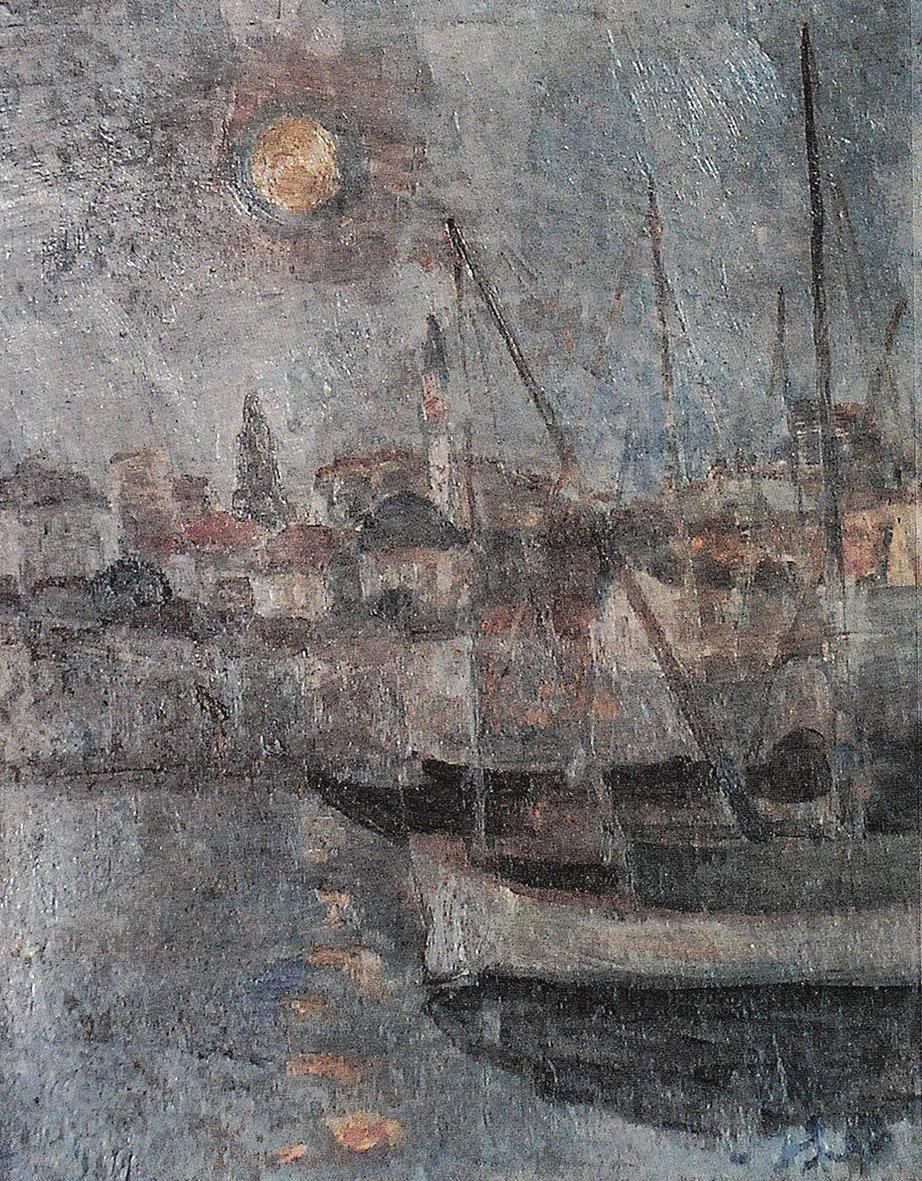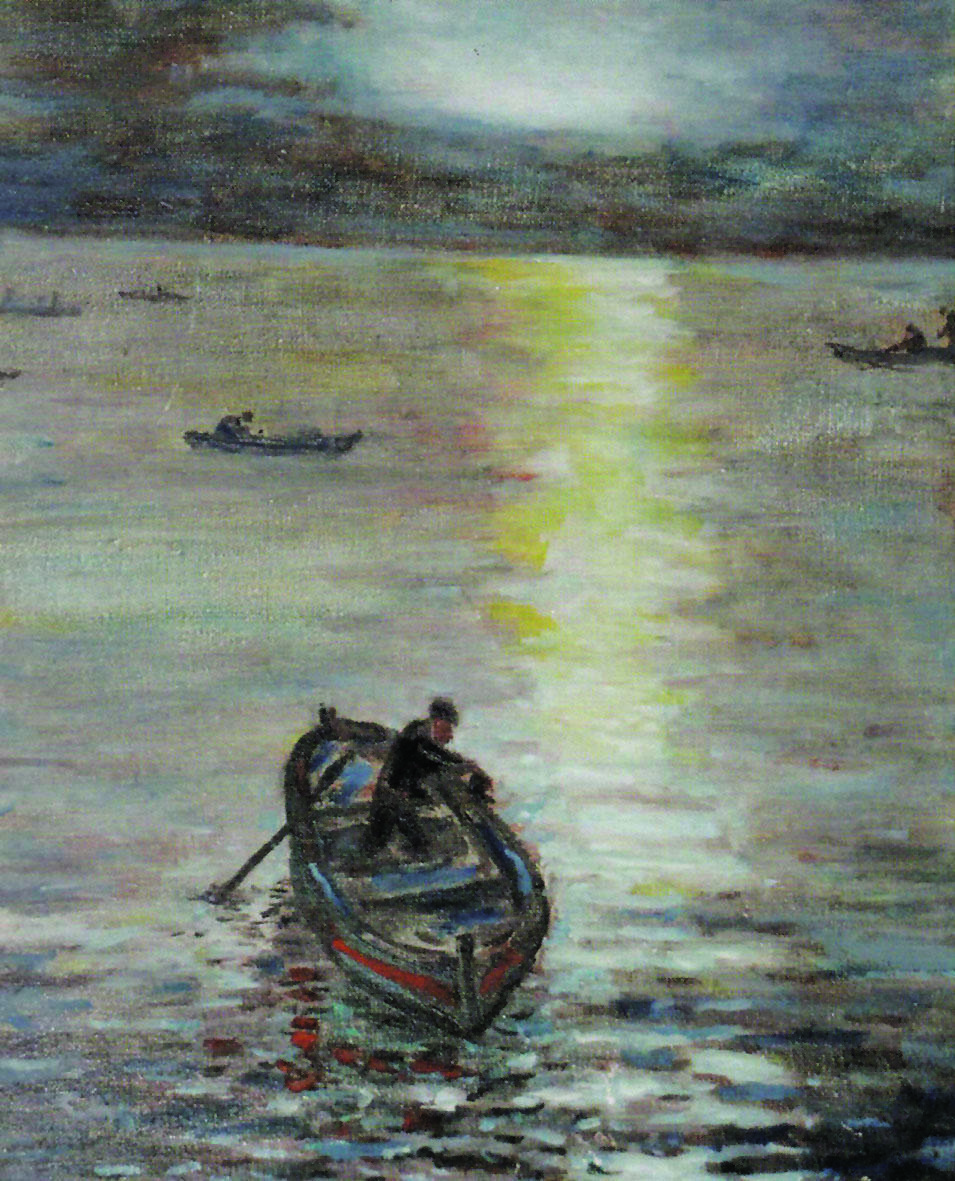Sailing by the moon on the Ottoman Bosphorus
Niki Gamm

A typical caique on the Bosphorus. Giovanni Brindesi.
 We’ve been reminded several times this summer that the moon was going to appear fuller than it usually did, an occasion that happens only once in 13 years. But the moon has always fascinated people, and the Ottomans were no exception. It must have seemed even more marvelous to them without the dimming of its light due to electric lights and pollution than it does to us today.
We’ve been reminded several times this summer that the moon was going to appear fuller than it usually did, an occasion that happens only once in 13 years. But the moon has always fascinated people, and the Ottomans were no exception. It must have seemed even more marvelous to them without the dimming of its light due to electric lights and pollution than it does to us today.The moon was considered beautiful so it’s not surprising to find in Ottoman poetry that the most attractive young people were compared to the moon. As Ahmed Paşa said in the second half of the 15th century, in a poem addressed to someone he was interested in:
“If it’s only with the stars you’re destined to be in accord/Ah, my moon, I’ll star the world with tear-drops day and night combined."
“Grace the summits of perfection with your presence, like the moon/ I’m content to look upon you even from this far behind,” (“The Penguin Book of Turkish Verse”).
Although the Ottomans did feel that exposure to moonlight could be injurious just as Europeans did, it didn’t stop them from romanticizing the moon, referring to its light as a silvery cypress. Just when it first became fashionable to go boating along the Bosphorus in the moonlight isn’t clear. Some historians date it to the reign of Sultan Selim II (1566-1574), who acquired a reputation for debauchery. Villages dotted the shoreline here and there, and summer houses belonging to the wealthy became popular as the Ottoman sultans built small palaces or hunting lodges along the water. Others date these moonlight boating excursions to a later period such as the so-called Lale Devri (Tulip Period) between 1718 and 1730.
The only means of travel between the Asian and European shores was by caique or sail boat until the second half of the 20th century. The caique was an elegant-looking boat propelled by a number of rowers, depending on its size and the wealth of its owner. The largest caiques naturally belonged to the sultan, and wherever he went, he would be followed by his entourage while people would watch from the shore. We don’t know of any sultans indulging themselves on moonlight tours, but it would be surprising if they didn’t.
In the 16th century, the Egyptian Halim Paşa took the lead in organizing moonlight boat trips because many yalıs (waterfront mansions) now lined the shores of the Bosphorus. Some of these tours might have lasted for two days with the morning spent in the gardens of this or that yalı enjoying a magnificent, leisurely breakfast.
The protocol for seating started with the bow of the caique. There, the host (male, of course) would sit with guests. Uğur Aktaş notes in his book “Istanbul’un 100 Adeti” published by Istanbul Culture, Inc., that the boat would already have been loaded with provisions such as drinking water, snow for cooling, nargile smoking sets and tobacco and ice cream. There would also be shawls in case the weather cooled off too much while they were out on the water. It’s very likely that the liquid of choice would be rakı in which case there would also be plentiful hors d’oeuvres.
 Musicians aboard
Musicians aboardExcursions that also offered food would stop in picnic areas like Göksu, Paşabahçe or Kalender before continuing their journeys. The larger caiques could even offer fish and kebabs on grills set up in the center. Sometimes the owners of the yalıs would invite the caique passengers to stop and would offer them sherbet and coffee in their gardens and, in the right season, the sound of the nightingale calling. Lighting would be with candles and lanterns, although in the yalı gardens, in which carpets had been spread out for people to sit on, there might be torches.
The rowers would be in the middle and in the stern would be musicians and singers to provide the music for the excursion. According to Aktaş, these musicians followed a set program that started out with fasıl (a special concert program) performed with a kemençe (a small three-string violin) and a tambur (lute) and was then followed by a solo and a peşrev (a four-part, classic composition). The formal part of the program over, the musicians would then turn to popular music of various kinds.
Aktaş doesn’t forget the less wealthy who couldn’t afford to hire their own musical group. It seems that they would rent caiques and go up the Bosphorus, following the caiques that did have musicians so that they too could hear the music. Some of the songs were so well known that everyone would join in and those on the shore could enjoy the concert as well. Composers and singers such as Nedim Bey, Kel Ali Bey, Kör Hüsam, Hafız Şaşı Osman and Lem’i Atlı, who was known as the Bosphorus nightingale, were among the most popular. After all, these were the days before huge tankers, container ships and ferries. The night only gave up the sounds of nature.
Abdülhak Şinasi Hisar wrote a book entitled “Boğaziçi Mehtapları” (Moonlights on the Bosphorus) that was divided in seven chapters that detailed everything from preparations to memories. To quote Hisar, “On an evening when the moonlight was at its highest, the caique, up to a hundred of which had gathered on the Bosphorus would come before Kalender which was accepted as the Bosphorus’ most poetic place at that time and began the moonlight excursion from there. Even if it’s not clear where they’ll be stopped, at which villages and in front of which yalıs, has begun an excursion that has more or less been calculated because almost everyone knows the places that are suitable for the fasıl performance. After Kalender the caiques are left to themselves in the Yeniköy current and from in front of İstinye to the other side. Because İstinye would have remained a little out of the way for the full moon. So the bay was the caftan cut out for the moonlight excursion because it offered the opportunity for the sound to be echoed during the singing. Especially during the nights of summer there was no place its equal for listening to the nightingales. After remaining here for a long time and performing several fasıl, they would again set out and would continue greeting the yalıs…
“Among these yalıs was the Emirgan yalı of Hıdıv İsmail Paşa who had the [best] place for the most famous entertainments and for the full moon. Up to 100 mostly Arab and Circassian singers had gathered on the yali’s terraces and when the caiques reached the yalı they joined in the fasıl; the result was a fabulous sound so much so that the voices that hit the hills of the bay across echoed along the Bosphorus. Then the return began…”
The moonlight excursion would end after midnight usually. Sait Halim Paşa organized some of these trips during the reign of Sultan Abdülhamid II but they stopped when the former went to Europe. The custom has occasionally been revived, but it’s not the same. The Bosphorus is too busy and too noisy and the lights of the city and bridges dim the full moon.
















